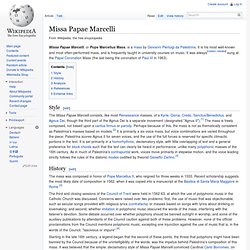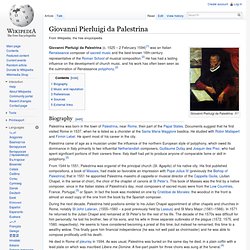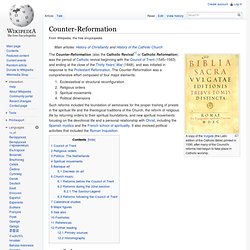

Missa Papae Marcelli. Style[edit] History[edit] The mass was composed in honor of Pope Marcellus II, who reigned for three weeks in 1555.

Recent scholarship suggests the most likely date of composition is 1562, when it was copied into a manuscript at the Basilica di Santa Maria Maggiore in Rome.[2] Starting in the late 16th century, a legend began that the second of these points, the threat that polyphony might have been banned by the Council because of the unintelligibility of the words, was the impetus behind Palestrina's composition of this mass. It was believed that the simple, declamatory style of Missa Papae Marcelli convinced Cardinal Carlo Borromeo, on hearing, that polyphony could be intelligible, and that music such as Palestrina's was all too beautiful to ban from the Church. On Saturday, 28 April 1565, by order of Cardinal Vitellozzi, all the singers of the papal chapel were gathered together at his residence.
Analysis[edit] Head-motif of Missa Papae Marcelli at first occurrence in the Kyrie. Giovanni Pierluigi da Palestrina. Giovanni Pierluigi da Palestrina Giovanni Pierluigi da Palestrina (c. 1525 – 2 February 1594)[1] was an Italian Renaissance composer of sacred music and the best-known 16th-century representative of the Roman School of musical composition.[2] He has had a lasting influence on the development of church music, and his work has often been seen as the culmination of Renaissance polyphony.[2] Biography[edit] Palestrina was born in the town of Palestrina, near Rome, then part of the Papal States.

Documents suggest that he first visited Rome in 1537, when he is listed as a chorister at the Santa Maria Maggiore basilica. He studied with Robin Mallapert and Firmin Lebel. Palestrina came of age as a musician under the influence of the northern European style of polyphony, which owed its dominance in Italy primarily to two influential Netherlandish composers, Guillaume Dufay and Josquin des Prez, who had spent significant portions of their careers there.
He died in Rome of pleurisy in 1594. Council of Trent. The Council in Santa Maria Maggiore church; Museo Diocesano Tridentino, Trento.

The Council of Trent (Latin: Concilium Tridentinum) was an ecumenical council of the Catholic Church. It is considered to be one of the Church's most important councils.[1] It convened in Trento, Italy, then the capital of the Prince-Bishopric of Trent of the Holy Roman Empire, between 13 December 1545, and 4 December 1563 in twenty-five sessions for three periods. During the pontificate of Pope Paul III, the Council fathers met for the first eight sessions in Trento (1545–47), and for the ninth to eleventh sessions in Bologna (1547).[2] Under Pope Julius III, the Council met in Trento (1551–52) for the twelfth to sixteenth sessions, and under Pope Pius IV, the seventeenth to twenty-fifth sessions took place in Trento (1559–63).
Background[edit] Obstacles and events before the Council[edit] Pope Paul III convoked the Council of Trent A General, Free Council in Germany[edit] Objects and general results[edit] Counter-Reformation. A copy of the Vulgate (the Latin edition of the Catholic Bible) printed in 1590, after many of the Council's reforms had begun to take place in Catholic worship.

The Counter-Reformation (also the Catholic Revival[1] or Catholic Reformation) was the period of Catholic revival beginning with the Council of Trent (1545–1563) and ending at the close of the Thirty Years' War (1648), and was initiated in response to the Protestant Reformation. The Counter-Reformation was a comprehensive effort composed of four major elements: Ecclesiastical or structural reconfigurationReligious ordersSpiritual movementsPolitical dimensions Council of Trent[edit] A session of the Council of Trent, from an engraving.
Pope Paul III (1534–1549) initiated the Council of Trent (1545–1563), a commission of cardinals tasked with institutional reform, addressing contentious issues such as corrupt bishops and priests, indulgences, and other financial abuses. Religious orders[edit] Politics: The Netherlands[edit]